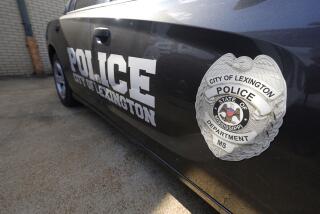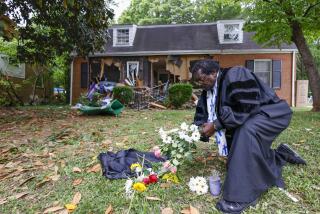In North Charleston, Jim Crow lives on in routine traffic stops, residents say
- Share via
Reporting from North Charleston, S.C. — To many black residents, the overt hatred and segregation that ruled this place during the Jim Crow era has morphed into something more insidious: the routine traffic stop.
Councilwoman Dorothy “Dot” Williams, who has been serving for 24 years, said she gets the same recurring complaint from constituents. They were pulled over for not signaling, for a registration tag that wasn’t visible or for a broken taillight — then asked to consent to a search.
“Then it escalates,” said Williams, 68. “If you say no, they arrest you for disorderly conduct, or worse.”
Walter L. Scott was pulled over under exactly such circumstances — a broken brake light — before Officer Michael T. Slager shot him to death as he tried to run away.
The video of Scott’s death, taken by a bystander with a cellphone, incensed Williams, but it did not surprise her.
She long assumed that police have killed black men with no justification. There was just no clear video to prove it.
The Rev. Thomas Dixon, an African American community organizer in North Charleston, said black residents have feared local police for years because of what he called “a culture of over-policing” that has led to excessive force and racial profiling.
The problem intensified in the early 2000s, when crime rates in North Charleston soared before leveling off after about 2005, Dixon said. Police responded by stepping up traffic stops, searches and arrests.
In a city that is 47.2% African American and 41.6% white, blacks were stopped almost twice as often, year after year, according to state law enforcement data of all stops that did not lead to an arrest or ticket.
From July 2007 to February 2015, the North Charleston Police Department, which is 80% white, pulled over black drivers 128,838 times.
In 2011, police pulled over black drivers 23,201 times — almost one stop for every other black resident. By last year, the number had dropped to 16,730.
Dixon said he and other civil rights leaders have met several times with top police officials to complain.
“The last thing you hear: ‘We’ll look into it and get back to you,’” Dixon said. “And then nothing changes.”
One day last winter, Tony E. Lewis said, he was pulled over by North Charleston police. He was puzzled. The 53-year-old painter and school board member said he wasn’t speeding or swerving.
An officer told him he had changed lanes without using his turn signal, Lewis recalled. The officer and his partner kept their hands on their holstered sidearms as they questioned him, he said.
When Lewis insisted that he had used his turn signal and threatened to call the officer’s superiors, the officer relented and issued a warning ticket, he said.
“It’s profiling — they look for any reason to stop black people,” he said.
North Charleston, like other Southern towns, has struggled to put segregation behind it.
The city grew out of the cotton, rice and indigo plantations north of the historic port of Charleston, a city famous for its colonial architecture and old Southern manners.
As the unincorporated area then known as the North Area grew and industrialized throughout the 20th century, blacks and whites were sharply separated by the white power structure — separate schools, pools, restaurants, theaters and neighborhoods.
Even after such segregation became illegal and the city incorporated in 1972, informal barriers remained.
Williams said she tried to buy a home in a white neighborhood in the 1980s. “I’ll never forget it,” she said. The man next door came outside with a pit bull and addressed her with the N-word: “You’ll never live next to me,” he told her.
She didn’t want to live next to him so she moved on.
She doesn’t run across that type of racial vitriol or denigration much anymore. She doesn’t see black Sambo ornaments in white people’s yards, she said.
Black and white people, especially the younger generation, mingle like never before. Williams often sees biracial couples strolling around, including her own children. She said she has biracial grandchildren.
She praises the white, Republican mayor, Keith Summey. “Let me tell you something,” she said. “Keith Summey is one of the kindest, best men I know. He loves black residents and would do anything for them.”
Summey regularly shows up at black churches — at Royal Baptist, Charity Baptist and Mt. Moriah Baptist — because he prefers “the old-time, kick-down music.”
He once hit 340 pounds, then underwent gastric bypass surgery and went on a diet.
But Williams said his love of soul food has held him back.
“He sneaks over to the black restaurants behind his wife’s back,” she said, laughing. “But that’s just Mayor Summey. Everybody knows it.”
He has been mayor for 20 years, and remained popular even after the devastating economic blow of the Charleston Naval Base’s closure.
It was Summey who announced Tuesday that Slager, who was fired from the police force, would face a murder charge.
“When you’re wrong, you’re wrong,” Summey told reporters. “When you make a bad decision, don’t care if you’re behind the shield or a citizen on the street, you have to live with that decision.”
When Summey stepped in to absorb heated questions aimed at the police chief, Eddie Driggers, a crowd of protesters didn’t want the mayor’s political hide. “We want Driggers! We want Driggers!” they chanted.
Their point was clear: The racial problems in the city stem from the police.
And this point is not exclusive to North Charleston.
Civil rights leaders have cited several recent cases in which black men were shot and killed in confrontations with police around the state.
On June 20, Denzel Curnell, 19, died during a struggle with a Charleston police officer who said he questioned Curnell because Curnell was wearing a hoodie in 85-degree heat — a sign that he planned criminal activity, the officer said.
Police ruled that Curnell shot and killed himself with his own gun during the struggle — an account the family challenges.
In Columbia, S.C., dashboard video led to the firing and prosecution of state Trooper Sean M. Groubert.
On Sept. 4, Groubert stopped Edward Levar Jones, 35, as he got out of his SUV in front of a convenience store.
“Can I see your license please?” Groubert asked.
Jones leaned into his Dodge Durango to grab it, when Groubert, 31, began screaming, “Get out of the car! Get out of the car!”
The officer fired at least four shots at Jones, who raised his hands as he stepped backward.
“I just got my license! You said get my license!” Jones said on the ground, wounded. “I got my license, right here. That’s my license.”
Jones was treated for a gunshot wound to the hip at a hospital and released.
Fifteen days later, Groubert was fired and charged with felony assault and battery “of a high and aggravated nature.”
He is awaiting trial. He faces up to 20 years in prison if convicted of all charges.
Dashboard cameras have limitations though. The video taken when Walter L. Scott was pulled over Saturday — released by state law enforcement Thursday — didn’t capture the altercation other than Scott running out of view.
On Thursday, the Charleston NAACP called for a state law to require police to use body cameras and demanded a federal investigation into the North Charleston Police Department and two other law enforcement agencies in Charleston County.
Dot Scott, the NAACP Charleston chapter president, said years of allegations by black citizens of police profiling and excessive force went unheeded until the release of the latest shooting video.
She said the killing would have been “swept under the rug” and the officer cleared of wrongdoing if not for the video.
Scott and other NAACP leaders called on residents to photograph or videotape any encounter they witness between police and citizens.
“This is not the first shooting in the back in North Charleston,” she said. “It’s just the first one on video.”
Twitter: @davidzucchino
Twitter: @JamesQueallyLAT
Twitter: @joemozingo
Zucchino reported from North Charleston and Queally and Mozingo from Los Angeles. Times staff writer Matthew Teague in Fairhope, Ala., contributed to this report.
More to Read
Sign up for Essential California
The most important California stories and recommendations in your inbox every morning.
You may occasionally receive promotional content from the Los Angeles Times.













